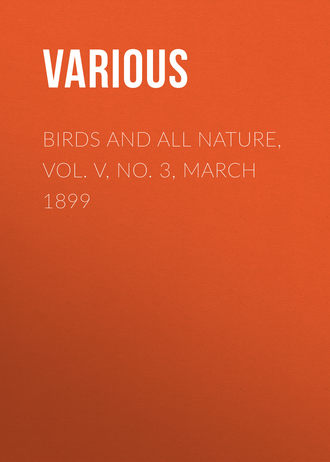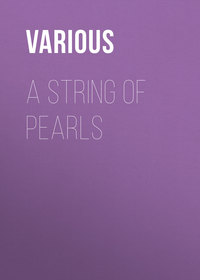
Birds and All Nature, Vol. V, No. 3, March 1899
The winter range of this "fish duck" is largely determined by the extent of open water on our lakes and streams. Thus it is regularly found in Minnesota wherever there is open water, even during the severest winters, but under other conditions it may be absent from regions much farther south. There can be little doubt that a large proportion of the individuals pass the winter well south, only a few being able to find subsistence about the springs and mouths of streams in the northern states.
Is it entirely due to individual taste, or may it be a difference in the food habits of these birds in different parts of the country that their flesh is highly esteemed in some regions but will scarcely be eaten at all in others? If it is true that the Michigan individuals eat snails, crabs, and mollusks rather than fish, and are therefore excellent for the table, while the California ones prefer fish and are therefore not fit for food, why have we not here a clear case of tendency to differentiation which will ultimately result in a good sub-species?
The nesting of the hooded merganser is even more erratic than its occurrence. It has been found nesting in Florida as well as in the more northern parts of the country, and here and there throughout its whole range, being apparently absent from many regions during the nesting season. It is unlike the other "fish ducks" in preferring still water and secluded streams, but resembles the wood duck in building its nest a short distance from the water in a hollow tree or stump or on the flat side of a leaning or fallen tree, often forty or more feet from the ground. The nest consists of weeds, leaves, and grasses with a soft lining of feathers and down. This warm nest must be intended to act as an aid to incubation rather than as a warm place for the young ducks, since they, like other ducks, are carried to the water in the beak of the mother-bird shortly after they are hatched. The nest complement ranges from six to eighteen eggs, the average being about ten. The eggs are variously described by different authors, both as regards color and size, from pure white, pearly white, creamy white, buffy white to buff-colored, and from 1.75 × 1.35, to 2.25 × 1.75 inches. The average size is probably nearly 2.10 × 1.72.
The downy ducklings are brown in color and, as they skim over the water, their pink feet churning up a spray behind, they present a bewitching picture. The male bird, like other ducks, assumes no share of the labors of incubation, but entertains himself hunting fish in some solitary stream where food is plentiful, and in proper season returns to assume the duties of the head of his lusty family.
The nesting season must necessarily vary greatly with locality. In Minnesota fresh eggs are found during the third week of April, according to Dr. P. L. Hatch. The date would probably be much earlier with the Florida birds. The locality selected for the nest is also variable with the different parts of the country.
The manner of flight of the different species of ducks is usually characteristic to the eye of the careful student. Thus the hooded mergansers fly in a compact flock of about a dozen birds with a directness and velocity that is wonderful. Dr. Hatch says, in his "Birds of Minnesota: " "Once in January, 1874, when the mercury had descended to 40 below zero, while a north wind was blowing terrifically, I saw a flock of six of this species flying directly into the teeth of the blizzard at their ordinary velocity of not less than ninety miles an hour." This may sound rather strong to some, but their flight is certainly very rapid, as any gunner will testify.
The "fish ducks," or mergansers, are an interesting group of three American species, of which the hooded is the smallest. The long, slender, toothed or serrated bill of this group provides a field character which will serve to identify them at a glance. It is to be hoped that their habit of feeding largely upon fish will prove a protection from entire extermination.
THE TRUMPETERS
The winds of March are trumpeters,They blow with might and main,And herald to the waiting earthThe Spring and all her train.They harbinger the April showers,With sunny smiles between,That wake the blossoms in their beds,And make the meadows green.The South will send her spicy breath,The brook in music flow,The orchard don a bloomy robeOf May's unmelting snow.Then June will stretch her golden days,Like harp-strings, bright and long,And play a rich accompanimentTo every wild bird's song.The fair midsummer time, apace,Shall bring us many a boon,And ripened fruits, and yellow sheavesBeneath the harvest-moon.The golden-rod, a Grecian torch,Will light the splendid scene,When Autumn comes in all the pompAnd glory of a queen.Her crimson sign shall flash and shineOn every wooded hill,And Plenty's horn unto the brimHer lavish bounty fill.– Andrew Downing.CLOVES
(Eugenia caryophyllata Thunberg.)DR. ALBERT SCHNEIDER,Northwestern University School of PharmacyBiron – A lemonLang – Stuck with cloves– Shakespeare, Love's Labor Lost, V. 2.CLOVES are among our favorite spices, even more widely known and more generally used than ginger. They are the immature fruit and flower-buds of a beautiful aromatic evergreen tree of the tropics. This tree reaches a height of from thirty to forty feet. The branches are nearly horizontal, quite smooth, of a yellowish grey coloration, decreasing gradually in length from base to the apex of the tree, thus forming a pyramid. The leaves are opposite, entire, smooth, and of a beautiful green color. The flowers are borne upon short stalks, usually three in number, which extend from the apex of short branches. The calyx is about half an inch long, changing from whitish to greenish, and finally to crimson. The entire calyx is rich in oil glands. The petals are four in number, pink in color, and drop off very readily. The stamens are very numerous. All parts of the plant are aromatic, the immature flowers most of all.
The clove-tree was native in the Moluccas, or Clove Islands, and the southern Philippines. We are informed that in 1524 the Portuguese took possession of these islands and controlled the clove market. About 1600 the Dutch drove out the Portuguese and willfully destroyed all native and other clove-trees not under Dutch protection. The plan of the Dutch was to prevent the establishment of clove plantations outside of their own dominions, but in spite of their great watchfulness other nations secured seeds and young plants and spread the cultivation of this valuable spice very rapidly. Now cloves are extensively cultivated in Sumatra, the Moluccas, West Indies, Penang, Mauritius, Bourbon, Amboyne, Guiana, Brazil, and Zanzibar – in fact throughout the tropical world. Zanzibar is said to supply most of the cloves of the market.
The cultivation of cloves in Zanzibar is conducted somewhat as follows: The seeds of the plant are soaked in water for two or three days or until germination begins, whereupon they are planted in shaded beds about six inches apart, usually two seeds together to insure against failure. The young germinating plants are shaded by frameworks of sticks covered with grass or leaves. This mat is sprinkled with water every morning and evening. The young plants are kept in these covered beds for nine months or one year, after which they are gradually hardened by removing the mat from time to time, and finally left in the open entirely for a few months, after which they are ready for transplanting.
Transplanting must be done carefully, so as not to injure the roots. The plant is dug up by a special hoe-like tool, lifted up in the hand with as much soil as possible, placed upon crossed strips of banana fibres, which are taken up by the ends and wrapped and tied about the plant. The plant is now carried to its new locality, placed in a hole in the soil, the earth filled in about it, and finally the banana strips are cut and drawn out.
The transplanted clove plants are now carefully tended and watered for about one year, but they are not shaded as during the first year of their existence. Usually many of the transplanted plants die, which makes replanting necessary. This great mortality, it is believed by some, might be reduced very materially by shading the recently transplanted clove-trees for a time.
The clove-tree may attain an age of from 60 to 70 years and some have been noted which were 90 years old and over. The average life of the plantation clove-trees is, however, perhaps not more than 20 years. The trees begin to yield in about five years after planting. The picking of the immature flowers with the red calyx is begun in August and lasts for about four months. From two to four crops are harvested each year. Each bud may be picked singly by hand, but those of the higher branches are more generally knocked off by means of bamboo sticks. After picking the flowers are placed upon grass mats and dried in the sun, this requiring from six to seven days. In the night and during rains they are placed under cover. Drying changes the red color of the calyx to a dark brown. The dried cloves are packed in gunny bags and carried to Zanzibar where an internal revenue of 25 per cent. is paid in cloves. From Zanzibar the cloves are exported in mat bags.
We know that cloves were used by the ancient Egyptians, for a mummy has been found with a necklace of them. The Chinese used them extensively, 226 B. C. Plinius briefly described "Caryophyllon," which, according to some commentators, referred to cloves and according to others to cubebs. Cloves appeared in Europe about 314-335 A. D., evidently introduced by way of Arabia. Emperor Constantine, who ruled about that time made Pope Sylvester of Rome, among other things, a present of 150 pounds of cloves. In Grecian literature cloves are first mentioned about the Sixth century. Trallianus recommended them in stomach troubles and in gout.
The Germans designate cloves as Gewürznägelein, which means spice nails, because of their resemblance to a nail, the corolla forming the head and the calyx tube the nail. The aromatic odor and pungent aromatic taste is due to an ethereal oil present in large quantities (18 per cent.) in the calyx tube. This oil is used for various purposes; as a clearing reagent in microtechnique, for toothache, as an antiseptic, stomachic, irritant. It destroys insects and keeps them away. When freshly extracted its color is pale amber but it gradually assumes a reddish brown coloration. It is one of the least volatile of ethereal or essential oils. It is also used by soapmakers and perfumers.
Cloves are variously used as a spice. They are often stuck into pickled fruits, as peaches, apples, apricots. The opening quotation from Shakespeare suggests such a use with lemons. Some persons acquire an inelegant and undesirable habit of chewing cloves. The pungent oil deadens or benumbs the nerves of taste and touch and the persistent mastication of cloves, is said to produce an excessive development of fibrous tissue of the liver, a condition akin to "nutmeg liver" which shall be referred to in our next paper.
Other parts of the clove-tree are also used occasionally, as for instance the flower stalks known as clove stalks. They possess the odor and taste of cloves but in a lesser degree. Formerly the leaves were also used but it is said that they do not now appear in commerce. The dried fruit known as mother of cloves is used more or less. They contain far less oil than cloves and are comparatively less valuable. Even the wood of the tree has been used as a spice. The dried and ground flower stalk, the fruits and the wood are often used to adulterate ground cloves. We would therefore advise housewives to purchase the cloves and grind them at home. It is reported that cloves have been adulterated with false cloves made from starch pressed into the form of cloves and roasted. It is, however, not at all likely that such a practice is carried on to any great extent. Sometimes cloves are placed on the market from which the oil has been extracted.
The cultivated cloves are richer in essential oil than the native cloves. The Zanzibar cloves are quite large. The principal market varieties are English cloves, Amboyne cloves, Bourbon cloves, Cayenne cloves, Zanzibar cloves, and others.
A VEIN OF HUMOR
ELANORA KINSLEY MARBLENOT only human beings, it is said, but all other animals of earth, air, and water have their play spells. To the question of how man can know this, one can only say that man being also animal, must certainly understand something of the nature of his lower brethren. Our mental composition is of the same substance as theirs, with a certain superstructure of reasoning faculty, however, which has enabled us to become their masters. The various emotions and faculties, such as love, fear, curiosity, memory, imitation, jealousy, etc., of which man boasts, are to be found, often in a highly developed state, among the lower animals, so that it is not at all surprising that among both birds and mammals we find individual species possessing a more or less keen sense of humor.
The question of why animals play is by no means new to philosophical inquiry. Herbert Spencer says animals play in their early or youthful stage of life because of their "surplus energy," the same reason that we ascribe to the child, referring more particularly to the strictly muscular plays, in contra-distinction to vocal recreation. An eminent philosopher, however, disagrees with him in this, contending that play in animals is not a mere frolicksome display of surplus energy, but a veritable instinct and a matter of serious moment as well as necessity.
However that may be, the fact remains that they do play and, as the writer can aver, in a spirit not at all serious, but with all the happy abandon of a child.
Among the wags of the feathered tribe the mockingbird and blue jay deserve special mention, though the raven, crow, catbird, jackdaw, and magpie may, from the point of mischief, be numbered in the list. In looking at the ungainly pelican one would smile to hear him called a "humorist," but as the seal is the buffoon of the aquarium, so the pelican plays the part of the clown in the zoo. His specialty is low comedy and generally the victims of his jokes are the dignified storks and the rather stupid gulls, companions in captivity. The stork's singular habit of standing on one leg affords the pelican a rare chance for a little fun, so he watches until a stork, in a meditative mood, takes up his favorite attitude beside the tank. Then up waddles the pelican and, with a chuckle, jostles against him, and sends him tumbling into the water. It is a question whether the stork enjoys the sport, but the pelican evidently does, for he leaps about evincing the utmost delight, flapping his wings, and squawking, or laughing, in triumph. The gulls he treats in a different fashion. No sooner does he see one seize a piece of bread, or some dainty contributed by a spectator, than up he rushes with a squawk and prodigious flapping of wings, forcing the gull to take refuge in the water, while he with much satisfaction devours the morsel.
"Our Animal Friends" tells of a pelican who made friends with a tiny kitten. When in a lively mood the pelican, perhaps recalling how his parents, or himself, in a wild state, were wont to catch fish, would pick up the kitten, toss it in the air, and stand with his huge mouth wide open as if intending to catch it as it came down. Puss seemed to consider it excellent fun, as with a quick motion she turned over in the air, alighting every time uninjured upon her feet; then off she would scamper to the pelican, running about his long legs as though seeking to knock him down. Watching his opportunity he would grasp her again, toss her into the air, and thus the sport would go on till the bird himself tired of it.
The mockingbird, that prince of song and mimics, possesses a sense of humor highly diverting and very humanlike – the male bird that is, for the female views life from a more serious standpoint, her domestic duties, it would seem, weighing heavily upon her mind. We speak of the "thieving" instinct of this bird, as well as of the blue jay, and other kindred species, because of that mischievous spirit which leads them to seize any small bright article which comes in their way, and, when unobserved, to secrete it. That they never purloin or hide these objects when observed is thought to be proof conclusive that it is done from the pure love of stealing and nothing else.
"I hide and you seek." In that childish game does not the one who is to secrete the article insist that the "finder" close his eyes till the object sought is carefully hidden? What amusement would be afforded the jay, or the mockingbird, should he attempt to secrete an article while you are looking? If we could only interpret the sparkle in their bead-like eyes, as we can that in a child's when engaged in the same game, how much mischief we would read there as the owner of these secreted articles hunts "high and low" for them in presence of the fun-loving birds!
"Where did you hide it, Jay?" pleaded a lady, who had left her silver thimble upon a table, and after a few minutes' absence returned to find it gone. "There has been nobody in the room since I left, so you must have taken it."
Mr. Jay, the pet of the household, hopped into his cage, and, standing upon his perch, looked demurely at the questioner.
"You are a naughty bird," said his mistress, who had in remembrance finger-rings, watch-keys, collar-buttons, and similar articles, which, from time to time, had as mysteriously disappeared, "and I am going to shut you in," which she did, fastening the insecure door of his prison with a stout piece of string.
Jay gave a shrill shriek, as of laughter, when his mistress continued the search, turning up the edge of the carpet, searching the pockets of garments hanging on the wall, anywhere, everywhere, that articles, one-time missing, had been secreted. But look where she would the thimble could not be found.
A month went by, and still Jay remained an unwilling, if not a subdued, prisoner. As his mistress one morning sat sewing in the room, Jay gave a final peck at the string which confined him, and at once, without a word, hopped to a chair from which one rung was missing. His mistress was watching him, and to her intense amusement saw him very deftly extract from the hole in the leg her lost thimble.
In the same household came, as visitor, a little boy named Johnny, of a very peevish and fretful disposition. When refused anything he especially desired, the whole house was made to resound with shrieks of: "Ma, ma, ma-a-a-a!"
Jay listened very attentively at first, but in a few days had not only caught the words but the very intonation. Johnny never entered the room without the bird crying in a peevish tone, in a very ecstacy of mischief: "Ma, ma, ma-a-a!"
"I hate that bird," said the boy one day, when Jay had greeted him with an unusually whining cry: "He ought to be killed. He makes me nervous."
"Then I would stop whining if I were you," suggested his mother, and Johnny wisely concluded he would.
A mockingbird which frequented the grounds of a gentleman in Virginia was noted not only as a most mischievous fellow, but as one of the most divine songsters of his tribe. So heavenly was his music, and so superior to that of his fellows, that at eventide in the general chorus his voice soared above all the rest. Men, women, and children gathered – for his fame had traveled far and near – to hear him sing, but in the very midst of his divine strains, Jip – for so they named him – would suddenly cease, and flying away, conceal himself behind a chimney on the housetop. Presently he would sneak down to the eaves and peer cautiously over, to see if his self-invited audience had scattered. If they were still there he would again hide himself, returning shortly to peer over the eaves again. As soon as the back of his last auditor was visible down he would fly to his chosen perch and resume his glorious song, tempting his audience to return. This time he would regale them with the choicest of his trills, breaking off in the midst as before and mischievously flying away to hide himself. This little comedy he would repeat three or four times during an afternoon or a moonlight night.
A black cat of the household was a recipient of his practical jokes. When she was passing Jip found it exceedingly amusing to spring upon her back, give her a sharp dig with his beak, and then spring nimbly to a low branch, exulting over the cat's vain effort to locate her tormentor.
A favorite joke of a mockingbird in Richmond, Va., was, when espying a dog, to utter a shrill whistle in exact imitation of a man summoning that animal. Thus peremptorily called, the canine would suddenly halt, prick up his ears, look up and down the street, then, seeing no master, trot on his way. Again the bird would whistle, but in a more mandatory tone than before. The dog would stop, gaze about in a puzzled manner, then, in response to another whistle, dash forward in the direction of the sound. The mystification of the dog appeared to afford the mockingbird the most delight, more particularly when not only one dog, but several would collect under his cage, whining and barking, vainly seeking to locate their masters.
Among the mammals, the elephant, in general estimation, possesses the drollest sense of humor. The writer never will forget the mischievous pranks of a huge fellow among a herd of elephants tethered in a pen in Central Park, New York. Only those beyond his reach escaped his teasing, his sinuous trunk tickling those near, now here, now there, his little pig-like eyes twinkling with genuine humor. His companions did not respond in kind, not feeling perhaps in a playful mood, which fact seemed in no way to diminish the big fellow's amusement, for he continued the sport at intervals much to the edification of the spectators.
Even when engaged in piling up huge slabs of lumber in the sawmills in India, these huge animals while away the tedious hours of labor by many a little prank or joke at the expense of their drivers. A favorite one is, after disposing of one load and returning for another, to fill their trunks with odds and ends as they move leisurely along, a stray nail, three or four pebbles, a tuft of grass with a bit of earth still clinging to its roots, a discarded cheroot, or other small articles which may lie in their paths. These are collected, and when the trunk is packed to their satisfaction, quietly curled upward and the mass blown against the naked stomachs of the drivers dozing upon their backs.
TAMING THE SMALLER WILD ANIMALS
ALDA M. MILLSTHERE is a great difference in the dispositions of the small wild animals, some quickly responding to care and petting, while others seem incapable of being tamed. It is the same with birds. I have found owls, hawks, and other species very easily tamed, while prairie chickens and quail appear to be incapable of domestication even in a small degree. They will lose considerable fear of human beings if left in their freedom to become accustomed to their near approach, but if placed in captivity they pine away and die, or, finding some avenue of escape, wander away and are lost. The nearest approach to domestication in the prairie chicken tribe I ever noted, was that of a young bird that grew up with a flock of young turkeys. We noticed it among the turkeys when they were quite small. The prairie chicken must have been considerably older than the turkeys, as at first it was larger than they were, but they rapidly gained on it and were soon much the largest. However, the little wildling clung to its adopted family and in the fall, when the turkeys came and roosted in the plum trees near the buildings, it came too and after a time lost most of its shyness and, strangest of all, adopted the turkeys' mode of roosting in the trees. Later on, however, it disappeared, probably joining a flock of its own kind.
The common striped ground-squirrel is very easily tamed if taken while young and will soon learn to come if called by name, and will learn many little tricks. The gray squirrels, though much prettier than the striped ones, are naturally shyer and harder to tame. Rabbits of the several species inhabiting the United States are capable of domestication in a degree, though of all I ever owned but one would return at my call when allowed its liberty out-of-doors. Western jack-rabbits when young make most interesting and beautiful pets, and, while confined, seem to lose all fear. Notwithstanding their prettiness and their soft cuddling ways, they are stupid little things, all their knowledge seeming to come through the calls of their appetites.









